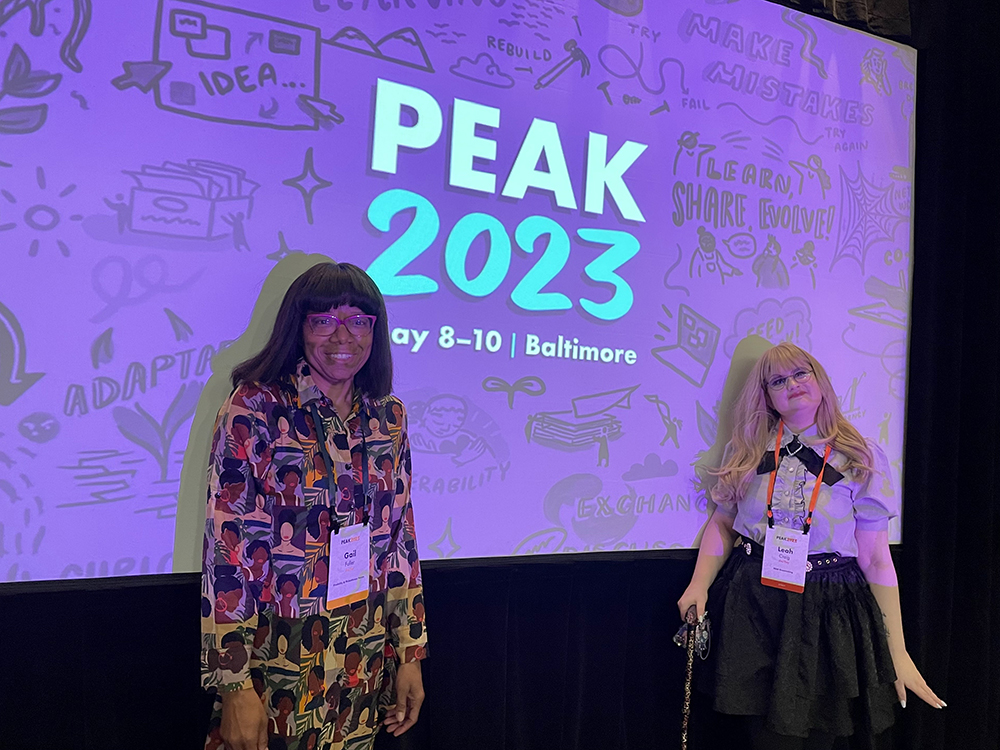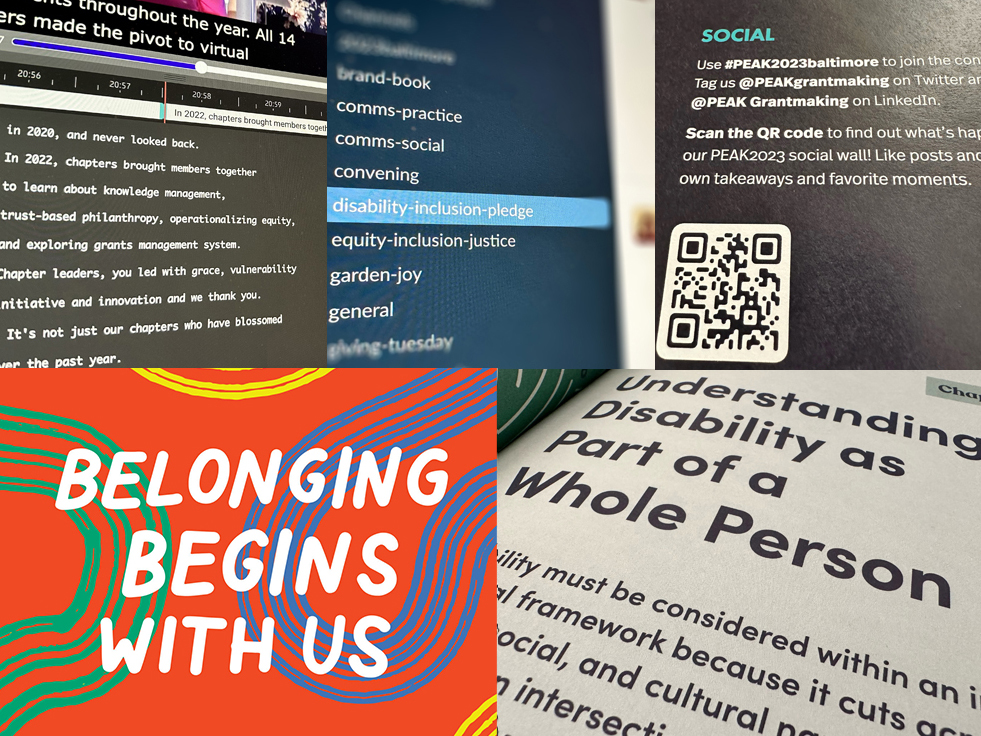Simple Ways for Philanthropy to Move Towards Greater Disability Inclusion

As a disabled person who has focused her career on disability inclusion and advocacy, the PEAK2023 session “Let’s Talk About Disability Inclusive Grantmaking” stuck with me in a multitude of ways, namely in how it illustrated that people with disabilities can take up space and thrive in a field that was not built for us.
Five disability advocates within the philanthropy field organized the panel: Gail Fuller, the senior director of communications and programs at the Disability & Philanthropy Forum; Charlotte Haase, communications and data manager at Maryland Philanthropy Network; Mareeha Niaz, director of programs at Grantmakers for Effective Organizations (GEO); Rachele Tardi, senior program officer at Robert Wood Johnson Foundation; and Kristy Trautmann, executive director at FISA Foundation.
Fuller and her fellow panelists offered a brief primer on systemic ableism, the state of ableism within the field of philanthropy and grantmaking itself, and a call to action: How can we create change? What gaps of knowledge need to be filled? How can we make the process of applying for and funding grants truly inclusive and intersectional by accommodating people with disabilities?
Systemic ableism in philanthropy
Systemic ableism is pervasive and ingrained within the philanthropy world, from the grant application process to allocation of funds to the (lack of) disabled staff and board members at foundations and grantmaking organizations. “So often, I hear funders say, ‘We don’t do disability,’” Trautmann said. And the statistics Fuller presented corroborated Trautmann’s lived experience. Only one penny every 10 grantmaking dollars goes towards disability rights and disability justice. “I find that people are afraid to say the word disability,” Haase added. Disabled and disability are neutral descriptors, a point continually emphasized throughout the session. Haase also brought an important point to the forefront of the conversation. If people are afraid to name disability, how can the philanthropy world move to disability inclusion and system change?
In order to achieve systemic change, Tardi mentioned the importance of using a disability justice lens in the work on disability. “As a foundation focused on health equity and on dismantling barriers to health caused by structural racism,” she said, “Robert Wood Johnson Foundation has been learning about how to include disability justice principles as a guide in our work, recognizing the leadership of people with disabilities and their different identities”.
Moving towards inclusion
As it stands, the process of moving towards inclusion is in its infancy. At the Disability & Philanthropy Forum, their Disability Inclusion Pledge created waves and was signed by leaders across the field, including FISA, GEO, Maryland Philanthropy Network, PEAK, and the Robert Wood Johnson Foundation. The Pledge is both a commitment and a call to action for funders and organizations to move beyond the Americans with Disabilities Act of 1990 (ADA) and into true intersectional inclusion.
The ADA is a landmark piece of civil rights legislation that offers legal protection for those with disabilities. It also sets a minimum legal standard for accessible public spaces. Think about accessible restrooms, ramps, curb cuts, or braille text and signage for those who are blind or low-vision. However, for all that the ADA offers, there are serious limitations as well. A piece of legislation cannot cover all the nuances of the variety of disabilities that exist and how it shows up in the world. This leads to the serious gaps Fuller and Trautmann described in their call to action at the panel.
“Accessibility barriers are not hypothetical or theoretical,” Trautmann said. She observed that digital grant applications are frequently incompatible with screen readers and other assistive technologies. This necessitates the continued use of paper applications in order to be more inclusive. But given the variety of technological solutions available to us today, there is no excuse for hosting inaccessible websites.
Of course, any discussion about disability inclusion would not be complete without a discussion of representation. The panel urged attendees to look at their staff and board and ask: Do they truly reflect inclusive hiring practices? Are these work environments meeting the needs of disabled staff and board members? Fuller reminded us that many folks may choose not to disclose a disability due to stigma or may live with a non-apparent disability. “I don’t use the term invisible disability because as a Black woman, I am not invisible,” Fuller said. My perspective irrevocably changed by that statement. I’m certain I’m not the only one in the audience who felt that way.
Incorporating inclusion into practice
As the presentation wrapped up, the panelists moved into the Q&A portion of the hour. Members of the audience lined up to ask the five a variety of different questions on how they incorporate disability inclusion into their own grantmaking practice.
I asked the panelists, “Despite the long way philanthropy as a field needs to improve with disability inclusion, are there any glimmers of positive change you’ve noticed so far?”
Trautmann looked out at the room. “This room gives me hope,” she said. “The fact that you are here is disruptive to philanthropy’s history and patterns of ignoring people with disabilities. This is what we need—to gather and learn together like this.”
Tardi added that the Disability Inclusion Pledge is a powerful tool to show our collective leadership, while welcoming the fact that each organization has a different starting point.
Niaz agreed. “When we include disability, we make benefits for others, and it creates a more equitable space for everyone.”
Hasse pointed out some of the changes made on a technological front. These included out-of-the-box captions and the ability to spotlight or highlight an American Sign Language interpreter on Zoom.
As we finished the hour, I sat in awe of the figures in front of me. I also thought of Gail’s words: What does it mean to show up? As someone with a non-apparent disability, I do not want to be invisible to others. Like Kristy, I can see the hope in a large room full of some of the most prominent funders in the country, sitting and eager to learn more about disability inclusive grantmaking.
Fuller wrapped up the session with a challenge for PEAK2023 attendees. She asked them, “How do you advocate for those with non apparent disabilities in your spaces? How do you create an environment where they feel able to ask for what they need?” Fuller reminded us grantmakers and leaders need to be leading and living with our values and working towards disability justice.
Photo: Gail Fuller (left) and Leah Craig at PEAK2023 in Baltimore



